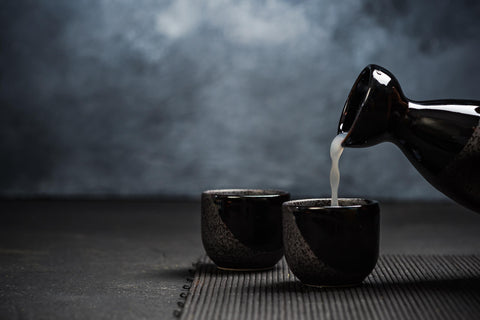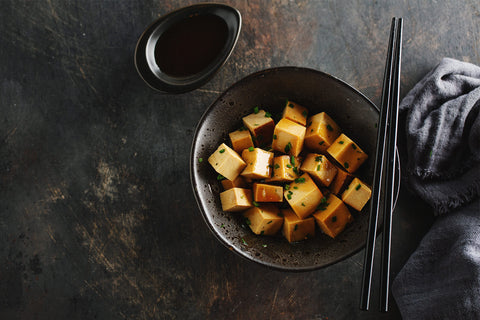
What is Sake?
Sake is an alcoholic beverage made by the fermentation of rice. It is commonly referred to as Japanese rice wine, though its method of production is closer to that of beer, first converting starch to sugar, before fermenting it into alcohol. Where the process differs is that this happens simultaneously, without having to separate the sugar prior to fermentation.
History
The history of sake is unclear. While archeological evidence suggests that fermented rice drinks were being produced in Japan since the third century BCE (around the time the country first adopted wet rice cultivation), there are no written records of alcohol consumption in Japan until the Book of Wei. This is a Chinese text from the third century AD and makes reference to the Japanese “drinking and dancing”. Japan’s first written history – the Kojiki, compiled around 712) – has several references to alcoholic drink that are romanised as sake.
For centuries, the drink was used in religious ceremonies and court festivals, and sake production was undertaken by the government. By the tenth century, the brewing of sake began to be conducted more by shrines and temples, which became the centre of the sake industry for more than 500 years. Documents dating to the 16th century show that the fundamental stages of the sake brewing process we know today was already well-established.
Production
To create a good-quality sake requires the right ingredients, a three-stage fermentation process, and a period of maturation. At each step, there are many opportunities produce a new variation of the drink, which is why so many sake breweries keep strict guidelines for their brewers.
What is Sake made from?
The key ingredients for sake are rice, water, and kōji-kin.
For premium sake, a special kind of rice is used. Saka mai (literally, sake rice) is not suitable for eating, has a larger grain than regular table rice, and contains less protein. Sake rice accounts for around a quarter of sake production in Japan, with the remainder using table rice. Prior to brewing, the rice is polished, more-so than rice that is intended for use as food. This intense polishing removes the outer layers containing high concentrations of proteins, vitamins, and fat, leaving the starchy core of the grain. These outer layers can result in off-flavours, producing a rough-tasting sake. However, highly-milled rice takes far longer to brew, making this premium sake more expensive.
Water is used in every part of the brewing process, from washing the rice, through creating the grain mash, to diluting the finished product, prior to bottling. The mineral content of the water can impact on the quality of the sake, with potassium, phosphoric acid, and magnesium being considered desirable elements, as they serve as nutrients for the yeast throughout the fermentation process. Traditionally, the water for brewing sake is obtained from wells, though modern breweries are as likely to use filtered tap water, with mineral elements added to the mix.
Kōji-kin is an enzyme-secreting fungus whose spores are used for a range of fermentation processes in Japanese cuisine. The spores are scattered across steamed rice to produce kōji, where they continue to germinate, releasing enzymes that convert rice starch into glucose. The addition of yeast helps to turn the glucose into alcohol.
Read more on Koji
Fermentation
Fermentation of sake is a three-step process, known as sandan shikomi. It involves the addition of steamed rice, water, and kōji-kin to a yeast starter (shubo) in separate stages over a period of days. This mixture forms the mash (moromi) used throughout fermentation.
Sake fermentation is unique in being as multiple parallel fermentation process. This means that starch converts into glucose, which immediately begins conversion into alcohol. This is different to beer fermentation, where the glucose has to be separated from the mash, and allows the process to take place in a single vat. The fermentation process takes around two weeks to complete.
Maturation
Like most brewed beverages, sake is at its best once given an opportunity to mature. Freshly-brewed sake is matured for between nine to twelve months until it is ready for bottling.Alternate sake methods
While the above process is the most common method of brewing sake, there are several alternative techniques that instil unique colours and flavours into the beverage. Some of the more common ones include:
Kimoto
Kimoto is the original method of sake-making, pre-dating the process detailed above. In this method, the brewer does not add lactic acid when creating the yeast starter. This means the lactic acid must develop on its own, resulting in a slower brewing time. Kimoto is often more robust and earthy in flavour as a result.
Yamahai sake
Like kimoto, yamahai is a method of brewing sake that requires the lactic acid to grow on its own, rather than adding it to the starter. The main difference between the two methods is that the steaming rice is not macerated with a stick in the yamahai process. These types of sake are well-regarded for their rich flavour profiles, which are often high in umami and rice tones.
Yamahai is a traditional way of making sake where, rather than adding lactic acid to deter microbes and bacteria from spoiling the fermentation, no lactic acid is added and thus the sake is left to ferment naturally.
Koshu sake
Koshu sake is an informal term meaning “old” or “aged” sake. It refers specifically to sake that has been left to age for some time, prior to sale. There are certain subdivision of koshu sake, such as jukusei koshu, which is sake that has been aged for three years of more. The ageing process makes sake darker in colour and more savoury in flavour, the longer it is left.
Muroka sake
Muroka sake accounts for a very small percentage of the sake brewed in Japan. Often referred to as “unfiltered sake”, the drink has bolder flavour profile than other types of sake, as well as its familiar straw-colored hue.
Storage
Exposure to direct light or heat can spoil sake, so it is best stored in a cool, dark room or a refrigerator. Once opened, premium sake begins to oxidise, which can affect the taste. Whilst keeping it in a refrigerator will help prevent spoilage, an opened bottle of sake is best consumed within a few days.Serving sake
Depending on the preference of the drinker, sake can be served reishu (chilled), jōon (at room temperature) or atsukan (heated). Hot sake is traditionally a winter drink, made using sake of a lower quality. Premium sake can lose its subtle flavours and aromas if heated.
Sake is poured from ceramic flasks called tokkuri into small cups called choko, which prevent heated sake from getting cold. By tradition, one does not pour one’s own sake, but rather members of a group pour drinks for one another.
Taste and flavour
Depending on the specific brewing process, sake can come in a wide variety of flavours. The label will often include the terms nihonshu-do, san-do, and aminosan-do, which help to give some indication of the taste.
Nihonshu-do: sometimes referred to as the Sake Meter Value (or SMV), this indicates the sake’s sugar and alcohol content, measured from sweet (-3) to dry (+10).
San-do: this number indicates acidity of the sake, with higher values for more acidic brews.
Aminosan-do: this value indicates a savoury or umami taste to the sake, produce by larger quantities of amino acids in the brew. The higher the value, the more savoury the sake.
While these three values can give a broad idea of the flavour and taste of the sake, many varieties boast a range of flavour notes including fruits, herbs, flowers, and spices.
Varieties
Sake falls into two major categories: futsū-shu (or, ordinary sake) and Tokutei meishō-shu (special-designation sake). Most sake is classed as futsū-shu, which is the sake equivalent to table wine. Tokutei meishō-shu is a premium sake, where the rice has been polished to a higher degree, eliminating more of the fats and proteins.
There are eight varieties of Tokutei meishō-shu, depending on quality. From highest to lowest, these are:
Junmai Daiginjō-shu (pure rice, very special brew): made using rice and koji rice, with 50% or less of the grain remaining after polishing.
Daiginjō-shu (very special brew): made using rice, koji rice, and distilled alcohol, with 50% or less of the grain remaining after polishing.
Junmai Ginjō-shu (pure rice, special brew): made using rice and koji rice, with 60% or less of the grain remaining after polishing.
Ginjō-shu (special brew): made using rice, koji rice, and distilled alcohol, with 60% or less of the grain remaining after polishing.
Tokubetsu Junmai-shu (special pure rice): made using rice and koji rice, produced by special brewing method, 60% or less of the grain remaining after polishing.
Tokubetsu Honjōzō-shu (special genuine brew): made using rice, koji rice, and distilled alcohol, with 70% or less of the grain remaining after polishing.
Junmai-shu (pure rice): made using rice and koji rice – no minimum amount of rice polishing specified. Honjōzō-shu (genuine brew): made using rice, koji rice, and distilled alcohol, with 70% or less of the grain remaining after polishing.
Popular Products
These are just some of the sake products and variations that prove particularly popular at SushiSushi.
TAKASHIMIZU JUNMAI
This is a pure rice sake that is great for everyday occasions It has a moderate acidity, a well-balanced body, and a refreshing flavour. Both earthy and sweet, the combination produces a smooth drinking experience.
SAKE HUNDRED - BYAKKO
This new product from Sake Hundred is a premium sake brewed using Yamagata Dewasansan organic rice. This premiem rice variant has 82% polished away prior to brewing, leaving this beverage with its smooth, pure flavour.
DARUMA MASAMUNE AGED SAKE
Umeshu is delicious plum sake that is easy to drink. Light and flavourful, it makes a great accompaniment to many Japanese dishes, or can be enjoyed on its own as a standalone beverage.
TENZAN YUZUSHU SAKE
Brewed and flavoured with the juice and zest of the Japanese yuzu fruit, yuzushu sake is a popular drink across Japan. Best served chilled, over ice, yuzushu sake has tart flavour notes that make for a refreshing drink.
Our Suppliers
Here at SushiSushi, we source our sake from some of the most well-respected and established producers in Japan. These include:
Takashimizu
Takashimizu was founded in 1944 as a result of the merging of 12 small sake breweries in the Akita city area. Their brewery is located in a place famous for the purity of its water, which helps them maintain the quality of their final products.Visit Website
Sake Hundred
The motto of Sake Hundred is “Fill your glass of life.” and they do both with their amazing range of sake products. Founded in 2018, this up-and-coming sake brand is already well known for its quality and vision.Visit Website
Daruma Masamune
Founded in 1835, Daruma Masamune’s brewery is located neat the centre of Japan, in Gifu City. Here they produce high-quality sake for everyday use, as well as premium, aged varieties with subtle and delicious flavour notes.Visit Website














